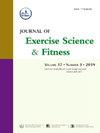Mediation of executive functions in the relationship between motor skills and psychosocial health in preschool children
IF 2.4
2区 医学
Q2 SPORT SCIENCES
引用次数: 0
Abstract
Purpose
Early motor skills develop alongside executive functions and psychosocial health. However, the interaction between these elements in early childhood is not well-studied. This study aimed to examine whether executive functions mediate the relationship between motor skills and psychosocial health.
Methods
A total of 452 children (mean age = 6.14 ± 0.29 years, 48.9 % female) were included in this cross-sectional study. The Movement Assessment Battery for Children-Second Edition (MABC-2) was used to assess motor skills. Executive functions were measured using the Go/No-Go Test, Dimensional Change Card Sort Test, and List Sorting Working Memory Test from the Early Years Toolbox (ages 3–7). Social skills and problem behaviors were assessed using the preschool version of the Social Skills Improvement System Rating Scale (SSIS-RS). Structural equation modeling (SEM) with maximum likelihood estimation was employed to examine the mediating role of executive functions.
Results
Gross motor skills were positively associated with inhibition (β = 0.41, p < 0.01), shifting (β = 0.20, p < 0.01), working memory (β = 0.30, p < 0.01), social skills (β = 0.50, p < 0.05), and negatively associated with problem behaviors (β = −0.23, p < 0.05). Inhibition (β = 0.107, p < 0.001) and shifting (β = −0.018, p < 0.05) mediated the relationship between gross motor skills and social skills. Additionally, inhibition (β = −0.086, p < 0.001) and shifting (β = 0.019, p < 0.05) mediated the relationship between gross motor skills and problem behaviors. Fine motor skills were positively associated with inhibition (β = 0.35, p < 0.01), shifting (β = 0.16, p < 0.01), and working memory (β = 0.21, p < 0.01), but not significantly related to social skills (β = 0.08, p > 0.05) or problem behaviors (β = 0, p > 0.05). Inhibition (β = 0.144, p = 0.001) mediated the relationship between fine motor skills and social skills, while both inhibition (β = −0.102, p = 0.001) and shifting (β = 0.014, p = 0.041) mediated the relationship between fine motor skills and problem behaviors.
Conclusion
Executive functions significantly mediate the association between motor skills and psychosocial health in preschool children. Future experimental studies are required to examine causality in young children.
学龄前儿童运动技能与社会心理健康之间执行功能的中介作用
目的:早期运动技能与执行功能和心理健康一起发展。然而,这些因素在儿童早期的相互作用还没有得到很好的研究。本研究旨在探讨执行功能是否介导运动技能和心理健康之间的关系。方法本研究共纳入452例儿童,平均年龄为6.14±0.29岁,其中女性48.9%。采用《儿童运动评估量表-第二版》(MABC-2)对儿童运动技能进行评估。执行功能采用“走/不走测试”、“维度变化卡片排序测试”和“早期工具箱列表排序工作记忆测试”(3-7岁)进行测量。社会技能和问题行为采用学前版社会技能改进系统评定量表(SSIS-RS)进行评估。采用最大似然估计的结构方程模型(SEM)检验执行功能的中介作用。结果粗大运动技能与抑制呈正相关(β = 0.41, p <;0.01),移位(β = 0.20, p <;0.01),工作记忆(β = 0.30, p <;0.01),社交技能(β = 0.50, p <;0.05),且与问题行为呈负相关(β = - 0.23, p <;0.05)。抑制作用(β = 0.107, p <;0.001)和移位(β = - 0.018, p <;0.05)在大肌肉运动技能和社交技能之间起中介作用。此外,抑制作用(β = - 0.086, p <;0.001)和移位(β = 0.019, p <;0.05)在大肌肉运动技能和问题行为之间起中介作用。精细运动技能与抑制呈正相关(β = 0.35, p <;0.01),移位(β = 0.16, p <;0.01),工作记忆(β = 0.21, p <;0.01),但与社交技能无显著相关性(β = 0.08, p >;0.05)或问题行为(β = 0, p >;0.05)。抑制(β = 0.144, p = 0.001)在精细动作技能与社交技能之间起中介作用,抑制(β = - 0.102, p = 0.001)和转移(β = 0.014, p = 0.041)在精细动作技能与问题行为之间起中介作用。结论学龄前儿童的执行功能在运动技能与心理社会健康之间具有显著的中介作用。需要进一步的实验研究来检验幼儿的因果关系。
本文章由计算机程序翻译,如有差异,请以英文原文为准。
求助全文
约1分钟内获得全文
求助全文
来源期刊
CiteScore
5.10
自引率
3.60%
发文量
54
审稿时长
31 days
期刊介绍:
The Journal of Exercise Science and Fitness is the official peer-reviewed journal of The Society of Chinese Scholars on Exercise Physiology and Fitness (SCSEPF), the Physical Fitness Association of Hong Kong, China (HKPFA), and the Hong Kong Association of Sports Medicine and Sports Science (HKASMSS). It is published twice a year, in June and December, by Elsevier.
The Journal accepts original investigations, comprehensive reviews, case studies and short communications on current topics in exercise science, physical fitness and physical education.

 求助内容:
求助内容: 应助结果提醒方式:
应助结果提醒方式:


